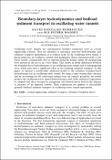Boundary-layer hydrodynamics and bedload sediment transport in oscillating water tunnels
Author(s)
Gonzalez-Rodriguez, David; Madsen, Ole S.
DownloadGonzalezRodriguezMadsen11.pdf (643.6Kb)
PUBLISHER_POLICY
Publisher Policy
Article is made available in accordance with the publisher's policy and may be subject to US copyright law. Please refer to the publisher's site for terms of use.
Terms of use
Metadata
Show full item recordAbstract
Oscillating water tunnels are experimental facilities commonly used in coastal engineering research. They are intended to reproduce near-bed hydrodynamic and sediment transport phenomena at a realistic scale. In an oscillating water tunnel, a piston generates an oscillatory motion that propagates almost instantaneously to the whole tunnel; consequently, flow is uniform along the tunnel, unlike the propagating wave motion in the sea or in a wave flume. This results in subtle differences between the boundary-layer hydrodynamics of an oscillating water tunnel and of a propagating wave, which may have a significant effect in the resulting sediment transport. In this paper, we present a zeroth-order analytical model of the turbulent boundary-layer hydrodynamics in an oscillating water tunnel. By using a time-varying eddy viscosity and by accounting for the constraints arising from the tunnel's geometry, the model predicts the oscillating water tunnel hydrodynamics and yields analytical expressions to compute bed shear stresses for asymmetric and skewed waves, both in the absence or presence of an imposed current. These expressions are applied to successfully quantify bedload sediment transport in oscillating water tunnel experiments.
Date issued
2011-01Department
Massachusetts Institute of Technology. Department of Civil and Environmental EngineeringJournal
Journal of Fluid Mechanics
Publisher
Cambridge University Press
Citation
Gonzalez-Rodriguez, David, and Ole Secher Madsen. “Boundary-layer Hydrodynamics and Bedload Sediment Transport in Oscillating Water Tunnels.” Journal of Fluid Mechanics 667 (2010): 48–84. © Cambridge University Press 2010.
Version: Final published version
ISSN
0022-1120
1469-7645